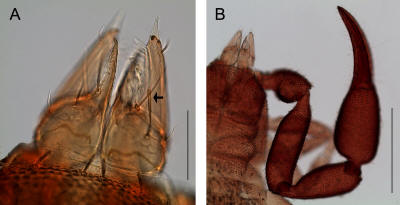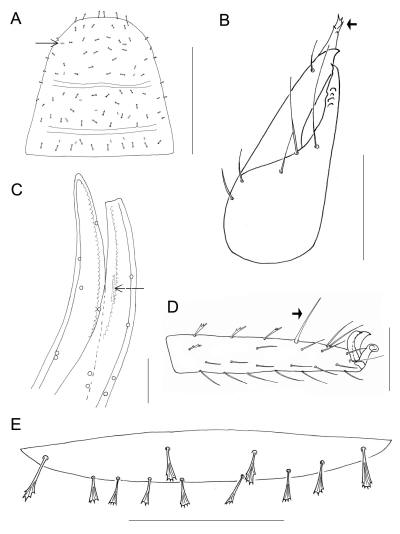|
Folia faunistica Slovaca (2011) 16 (2): 67-70 |
|
|
|
Allochernes powelli new to the fauna of Slovakia (Pseudoscorpiones: Chernetidae) |
||||
|
Jana Christophoryová1, Giulio Gardini2 & Stanislav Korenko3,4 |
||||
|
1 Department of Zoology, Faculty of Natural Sciences, Comenius University, Mlynská dolina B-1, SK–842 15 Bratislava, Slovakia [christophoryova@gmail.com] 2 Dipartimento per lo Studio del Territorio e delle sue Risorse, Università degli Studi di Genova, Corso Europa 26, I–161 32 Genova, Italy [giuliogardini@libero.it] 3 Department of Agroecology and Biometeorology, Faculty of Agrobiology, Food and Natural Resources, Czech University of Life Sciences Prague, Kamýcká 129, CZ–165 21 Prague 6 – Suchdol, Czech Republic 4 Department of Botany and Zoology, Faculty of Science, Masaryk University, Kotlářská 2, CZ–611 37 Brno, Czech Republic; [korenko.stanislav@yahoo.com] |
||||
|
Received: 1.7.2011; Accepted: 7.7.2011; Published: 14.7.2011 |
||||
|
Abstract |
||||
|
A pseudoscorpion, Allochernes powelli (Kew, 1916), was recorded for the first time from Slovakia. An illustrated description of male is provided based on its morphological and morphometric characters. The main diagnostic characters of the species are compared with other species of the genus Allochernes Beier, 1932 occurring in Slovakia. |
||||
|
Key words |
||||
|
Pseudoscorpiones, Allochernes, faunistics, new records, taxonomy, Slovakia, Central Europe. |
||||
|
Introduction |
||||
|
Fifty two species of pseudoscorpions are known from Slovakia (Christophoryová et al. 2011), including the first regional record of Allochernes powelli (Kew, 1916). The genus Allochernes Beier, 1932 includes 31 species and 2 subspecies distributed in North Africa, Asia and Europe (Harvey 2009). The pseudoscorpion Allochernes powelli is known from several European countries – Austria, Belgium, Croatia, Denmark, France, Germany, Greece, Hungary, Ireland, Italy, Netherlands, Portugal, Spain, United Kingdom and Turkey (Harvey 2009) and the species is characterised by relatively high variability of morphological and morphometric characters (Callaini 1986). Chernes creticus Beier, 1931 (loc. typ.: Crete, Greece) and Allochernes (A.) italicus Beier, 1932 (loc. typ.: Liguria, Italy) are considered junior synonyms of Chelifer (Chernes) powelli Kew, 1916 (loc. typ.: England, U.K.) respectively by Mahnert (1979) and Beier (1967). The aim of the present study is to describe the new finding of Allochernes powelli in detail and to propose an identification key to the Allochernes species from Slovakia. |
||||
|
Materials and methods |
||||
|
One male of Allochernes powelli is examined: Slovakia, south-facing slope of Kozie Chrbty Mts., Hranovická dubina National Nature Reserve, locality Zámčisko (49°00‘N, 20°17‘E, 780 m a.s.l.; leg. S. Korenko) – formaldehyde trap situated in xerotherm oak forest (fig. 1), 21.5.–14.6.2005. The specimen was determined by G. Gardini and J. Christophoryová using the identification keys of Legg & Jones (1988) and Mahnert (2004). The specimen was studied as temporary slide mount, photographed using a Leica DM1000 compound microscope with ICC50 Camera Module (LAS EZ application, 1.8.0). Measurements were taken from the photographs using the AxioVision 40LE application (v. 4.5). The material is deposited in the first author collection in the Comenius University, Bratislava.
|
||||
|
Results |
||||
|
Male (figs 2, 3): Anterior part of carapace and palps reddish-brown; vestitural setae on the body and pedipalps short, dentate and clavate (fig. 3A). Carapace (fig. 3A): granulate and rectangular without cucullus, epistome absent, anterior margin of the carapace straight, approximately as long as broad, with two distinct transverse furrows; eyes absent; chaetotaxy of carapace: carapace with 79 setae, posterior margin with 10 setae (fig. 3A); 4 slitlike lyrifissures present in anterior part of carapace, 10 lyrifissures behind anterior furrow (fig. 3A). Chelicerae (figs 2A, 3B): small, slightly sclerotized, 5 setae on cheliceral hand, one on cheliceral movable finger; movable cheliceral finger with slender well-developed galea, main stalk with approximately 5 short terminal rami (fig. 3B); cheliceral rallum of three blades; small, largely unsclerotized teeth situated on both movable and fixed finger of chelicera; right chelicera with anomalous subbasal seta lanceolate (fig. 2A).
Palps (figs 2B, 3C): more robust, strongly and markedly granulate (fig. 2B); chelal fingers with normal number of trichobothria (8 on fixed, 4 on movable), venom apparatus developed only in movable finger; each finger medially with only 1 accessory tooth; fixed finger with approximately 35 teeth and movable finger (without broken part) with 31 teeth (fig. 3C). Legs with one tarsal segments, subdistal pseudotactile seta of pedal tarsus IV present (fig. 3D), seta longer than width of tarsus (length of seta 0.7 mm, width of tarsus 0.5 mm). Tergites medially divided, chaetotaxy of tergites I – IX: 11: 14: 14: 17: 21: 20: 18: 16: 18: 17: 11, tergite X without a pair of relatively long tactile setae (fig. 3E). Male genital operculum anteriorly with 25 setae and 2 lyrifissures, posteriorly with 17 setae and 2 lyrifissures.
Measurements (in mm) and ratios: Body: length 1.72. Carapace: 0.63/0.61 (anteriorly 0.28) (ratio x1.03). Chelicerae: 0.19/0.09 (x2.11); movable finger length 0.14; galea length 0.04. Pedipalps: femur 0.61/0.17 (x3.59); patella 0.50/0.19 (x2.63); chela 0.98/0.26 (x3.77); hand 0.53/0.26 (x2.04), hand without pedicel length 0.46; finger length 0.49. Leg I: femur 0.23/0.09 (x2.56); tibia 0.25/0.07 (x3.57); tarsus 0.29/0.05 (x5.80). Leg IV: femur 0.52/0.14 (x3.71); tibia 0.38/0.08 (x4.75); tarsus 0.31/0.05 (x6.20). |
||||
|
Discussion |
||||
|
The known records of A. powelli came from specimens collected mainly in synanthropic habitats (Meinertz 1964; Beier 1967; Legg & Jones 1988; Gardini 2000), near caves or in their entrances (Beier 1931; Mahnert 1979; Zaragoza 2007) and in leaf litter and soil (Beier 1963; Mahnert 1990; Kárpáthegyi 2007). Drogla & Lippold (2004) found 524 specimens in Germany, from which 468 were collected in synanthropic habitats, 38 in compost heap, 16 in tree hollows and 2 under tree bark. In Slovakia, the male was found in pitfall-trap in a xerotherm oak forest. The main taxonomic characters of the studied male correspond to the published descriptions of Helversen (1966), Legg & Jones (1988) and Mahnert (2004), despite registering greater variability in morphometric characteristics and in number of setae of male genital posterior operculum. Identification key to the Allochernes species from Slovakia: 1 Tergite XI with a pair of relatively long tactile setae .......... Allochernes peregrinus Lohmander, 1939 – Tergite XI without a pair of tactile setae .......... 2 2 Pedal tarsus IV without subdistal pseudotactile seta; half-tergites VI – VIII with 10 – 12 setae on their posterior margin (without lateral and medial setae); palpal femur widest in its subbasal part .......... .......... Allochernes wideri (C.L. Koch, 1843) – Pedal tarsus IV with subdistal pseudotactile seta; half-tergites VI – VIII with at most 8 setae on their posterior margin (without lateral and medial setae); palpal femur widest in its middle part .......... .......... Allochernes powelli (Kew, 1916) |
||||
|
Acknowledgements |
||||
|
We are grateful to Alica Christophoryová for technical assistance with figures and our colleague Volker Mahnert (Switzerland) for his help, criticism and comments. The study was supported by the projects VEGA 1/0176/09 and MSM 6046070901 of the Ministry of Education, Youth and Sports of the Czech Republic. |
||||
|
References |
||||
|
|

